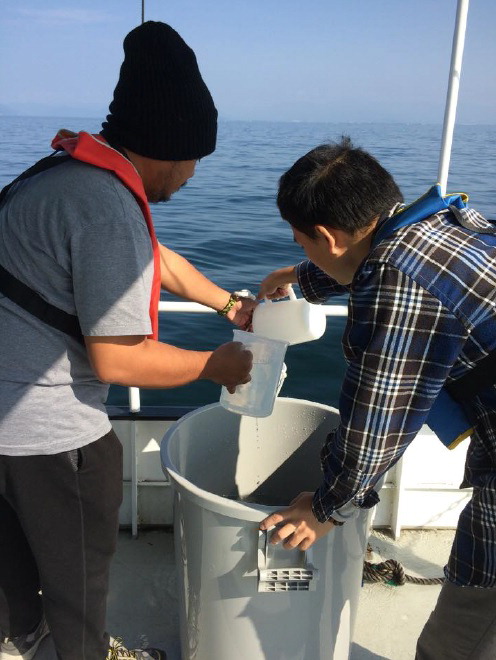Throughout the project, the research team collaborated with experts from the California Academy of Sciences (CAS). The collaboration with CAS researchers helped develop the skills and capacity of the research team to better manage the scientific collections obtained from the various sampling expeditions in Lake Taal. Team members learned sampling techniques, collections management, organization and database creation during a one-month stay at CAS. The training received by the team will be instrumental in establishing a natural history collection at University of St. Thomas. The visit also gave team members a chance to write several papers based on the gathered results, some which have already been published under peer-review.
The research results were shared through peer-reviewed publications, presentations and discussions with government agencies, conservation and community groups, as well as a pioneering museum exhibit entitled “Taalaman: The Lake’s First Biomuseum”.
Students enrolled in the Biodiversity and Conservation Biology course in the UST Graduate School had to learn independently how to mount an exhibit featuring biodiversity. The Taalaman museum exhibit helped increase public awareness on the importance of Lake Taal as a biodiversity hotspot, given how its native flora and fauna must cope with external pressures and was well-received by both the scientific community and the general public. The exhibit had many walk-in visitors. A video of live specimens of the Lake Taal sea snake (
Hydrophis semperi), was uploaded to social media and created a lot of buzz.
The PEER grant was also the catalyst for the first Philippine Symposium on Freshwater Biodiversity and Ecosystems, which provided a venue for the dissemination of recent research findings on different freshwater ecosystems in the country, including those conducted by the PEER project members in Lake Taal and led to the establishment of the Philippine Society for Freshwater Sciences, which will organize future symposiums and serve as a professional organization of freshwater biologists in the country. The involvement of young scientists, including a majority of female team members, in all aspects of the project may help build a more educated and scientifically inclined Philippine community.
Their research activities relied heavily on collaborative work, particularly with government agencies. From the beginning, the team linked up with NGO partner Pusod, Inc., and the Protected Areas Superintendent of the Taal Volcano Protected Landscape office. During the Lake Taal Research Summit, findings were reported to the top officials of the regional office of the Department of Environment and Natural Resources (DENR), with the hope that they will utilize the results to improve conservation policies.
The PEER team shared with the Bureau of Fisheries And Aquatic Resources new recommended spacing between monitoring sites for a more comprehensive and cost-efficient monitoring of water quality in aquaculture areas in the lake, as well as additional biological and chemical data important for monitoring water quality trends.
Bureau of Fisheries Aquatic Resources also provided live specimens for display during the Taalaman exhibit. The researchers collaborated with other academic institutions in the Philippines including the National Museum, University of the Philippines, Diliman and the Ateneo de Manila University.
The PI was also recipient, as a project member, of two new collaborative research grants covering biodiversity and nutrient cycling totaling more than $130,000 USD.
PublicationsPontillas KIP, Aaron EM, Calicdan SPM, Conda JAV, Santos JMA, Tordesillas DT and RDS Papa. 2016. Contributions from the UST Taal Biota Project (2014-2016): The littoral meiobenthic fauna of Lake Taal.
Trans. Nat. Acad. Sci & Tech. (Philippines) 38(1): 112. ISSN 0115-8848.
Briones JCA, Papa RDS, Cauyan GC, Urabe M. 2015. The first report of three acanthocephalan parasite species isolated from Philippine fishes.
Helminthologia 52(4): 384-389.
https://sciendo.com/article/10.1515/helmin-2015-0061Tordesillas DT, Abaya NKP, Dayo MAS, Marquez LEB, Papa RDS and S Ban. 2016. Effect of temperature on life history traits of the invasive calanoid copepod
Arctodiaptomus dorsalis (Marsh, 1907) from Lake Taal, Philippines. Plankton and Benthos Research ONLINE ISSN: 1882-627X PRINT ISSN: 1880-8247
https://www.jstage.jst.go.jp/article/pbr/11/4/11_P110404/_articleGerong APV, Caballes GLP, Orellana PD, Sta. Ana CA, Legaspi KL, Briones JCA, Papa RDS. 2015. The distribution of submerged macrophytes in the littoral zones of Lake Taal.
Philippine Scientist 52: 40-55
Tordesillas DT, Abaya NKP, Dayo MAS, Marquez LEB, Almario JFM, Datugan CB, Papa RDS. 2015. Laboratory culture of
Mongolodiaptomus birulai (Rylov, 1923) and
Arctodiaptomus dorsalis (Marsh, 1907) (Calanoida, Diaptomidae).
Trans. Nat. Acad. Sci & Tech. (Philippines) 37( 1): 73. ISSN 0115-8848





